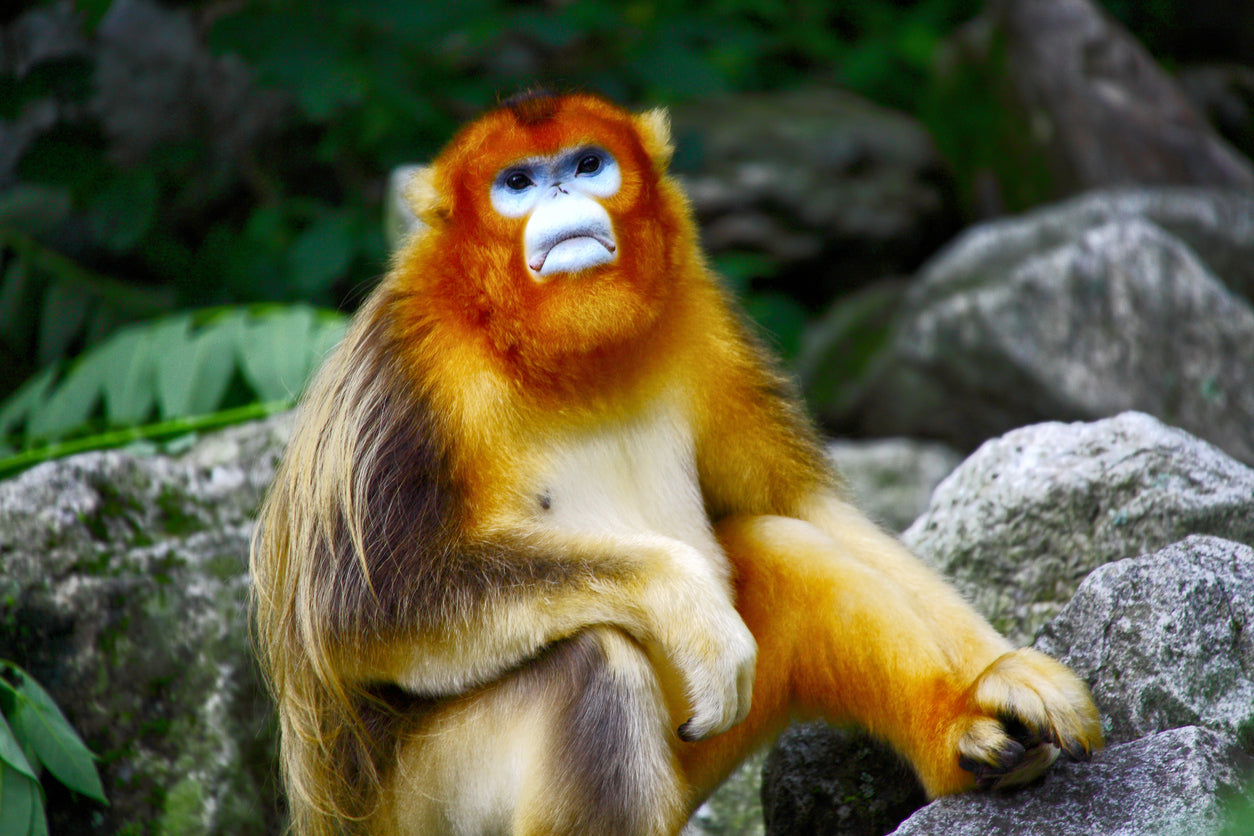
Photo: 9292lo via Getty Images
The Golden snub-nosed Monkey (Sichuan golden hair Monkey) is endemic to a small central and southwest China region. It is found in the mountainous forests of the Sichuan, Shaanxi, and Gansu provinces. The monkey is also known as the Chinese Golden Monkey, Sichuan Snub-nosed Monkey, or Shaanxi Snub-nosed Monkey.
Today's GB blog focus will be on the Golden snub-nosed Monkey; we will explore their physical appearance, diet, conservation, exciting facts, and habitat.
So, let's get started!
Description and Appearance

Photo: guojieyi via Getty Images
The golden snub-nosed monkey is a primate species endemic to central and southwestern China. It inhabits temperate, mountainous forests up to an altitude of 3,800 m.
Adults weigh between 8 and 15 kg, and males are larger than females. It has a grey-golden cloak, with the hair on its head somewhat paler than its body.
The tips of the hair are often orange or reddish. The face is bare except for a short muzzle and whiskers around the mouth. They have white tufts of hair on their cheeks and long hair over their ears.
Their tail is long, measuring approximately 70 cm in length.
Males have large canine teeth, which they use in confrontations with other males. Females give birth to a single offspring after a gestation period of around seven months.
The young remain with their mothers for up to three years before becoming fully independent. The golden snub-nosed monkey is a social animal living in troops of up to 30 individuals. They are diurnal, meaning they are active during
Diet
Unlike most other monkeys, mainly herbivores, the Golden Snub-nosed Monkey is an omnivore. In addition to eating leaves, fruits, and flowers, they also enjoy eating insects, eggs, and even small mammals. This diverse diet helps them survive in their harsh mountain habitat, where food can be scarce. So, the next time you see a picture of a Golden Snub-nosed Monkey, remember that there's more to this little creature than meets the eye.
Reproduction
The golden snub-nosed monkey is a polygynous species, meaning that male’s mate with multiple females.
The mating season typically lasts from September to November; however, breeding behavior is displayed. Gestation lasts for seven months, and infants are born between March and May. The female usually gives birth once every two years.
The lifespan of the golden snub-nosed monkey is 20-25 years.
Although further research is needed, it is believed that the golden snub-nosed monkey exhibits some level of paternal care. For example, males have been observed guarding and protecting infants from predators such as birds of prey. Additionally, males have been seen to play an active role in group defense, helping to safeguard both infants and mating females from rival groups. Together, these behaviors suggest that golden snub-nosed monkeys exhibit some degree of paternal investment in their offspring.
However, more research is needed to confirm this hypothesis.
Distribution & Habitat
The Golden Snub-nosed Monkey is found throughout central and southwestern China.
In the north, their range extends from Shaanxi Province south to Sichuan Province and into southeast Tibet.
In the south, they range from Yunnan Province west into southern Tibet. There are also small populations in Burma and Laos.
The monkey lives in a mountainous forest at altitudes between 1,300 and 4,800 meters, where there are a variety of trees and bamboo. They do not occupy primary forest but prefer mixed deciduous forest with evergreen and coniferous trees and bamboo.
They have also been found in areas that have been degraded by human activity, such as logging operations. Preferred habitats have an abundance of fruit trees and young bamboo shoots.
The Golden Snub-nosed Monkey is diurnal and arboreal, spending most of its time in the trees. They travel in troops that can number up to 500 individuals but split into smaller groups when feeding.
Home ranges vary in size depending on food availability but have been estimated to be between 3 and 40 square kilometers. Studies have shown that groups will defend their home range against other groups of Golden Snub-nosed Monkeys.
You can have this Golden Snub-Nosed Monkey Soft Stuffed Plush Toy in your home, and we hope you will take good care of it.
Conservation

Photo: Cn0ra via Getty Images
The Golden Snub-nosed Monkey is an endangered species with a declining population. Alarmed researchers and conservationists are working hard to protect these beautiful animals and their habitats.
The primary threat to the Golden Snub-nosed Monkey is habitat loss due to deforestation. As their natural homes are destroyed, monkeys are forced to compete for resources, putting them at risk of starvation or conflict with other animals.
In addition, the illegal wildlife trade poses a serious threat to the Golden Snub-nosed Monkey. Poachers capture and sell these monkeys as pets or for use in traditional medicine, which further reduces their numbers in the wild.
Conservation efforts are focused on protecting existing monkey populations and their habitats and raising awareness about the importance of preserving this endangered species. With the help of dedicated conservationists, the Golden Snub-nosed Monkey has a fighting chance at survival.
Other Interesting Facts
These interesting facts will make you want to learn even more about the Golden Snub-nosed Monkey!
- Their fur changes throughout the year to help them better adapt to the seasons. In winter, their fur is thicker and darker to keep them warm, while in summer, it is thinner and lighter in color to help them stay calm.
- They are highly social animals that live in troops of up to 500 individuals.
- They are very vocal animals, using over 18 different sounds to communicate with each other.
- The Golden Snub-nosed Monkey is an acrobatic species known for its fearless jumping abilities.
- They are one of the few monkey species that exhibit paternal care, with males playing an active role in protecting infants and females from predators.
Final Thoughts
These cute stunning creatures are in danger and need our help! We must do what we can to protect their habitats and raise awareness about the importance of preserving this endangered species. With the help of dedicated conservationists, the Golden Snub-nosed Monkey has a fighting chance at survival.
Cheers!
~GB


Deja un comentario